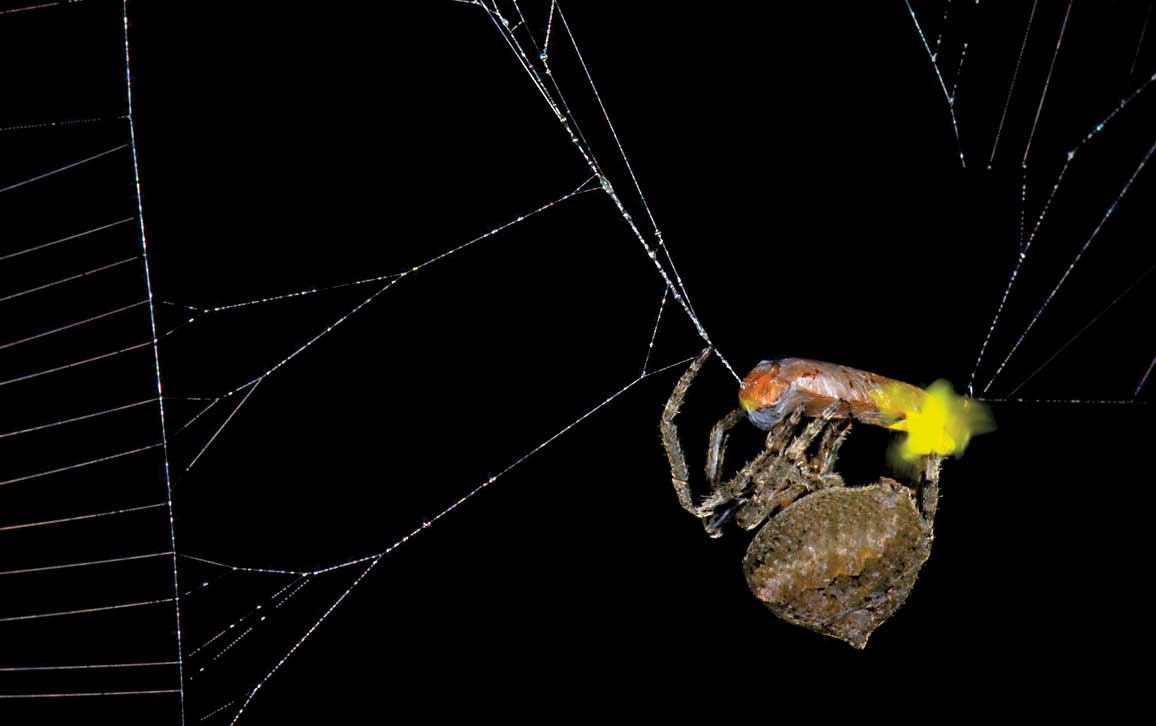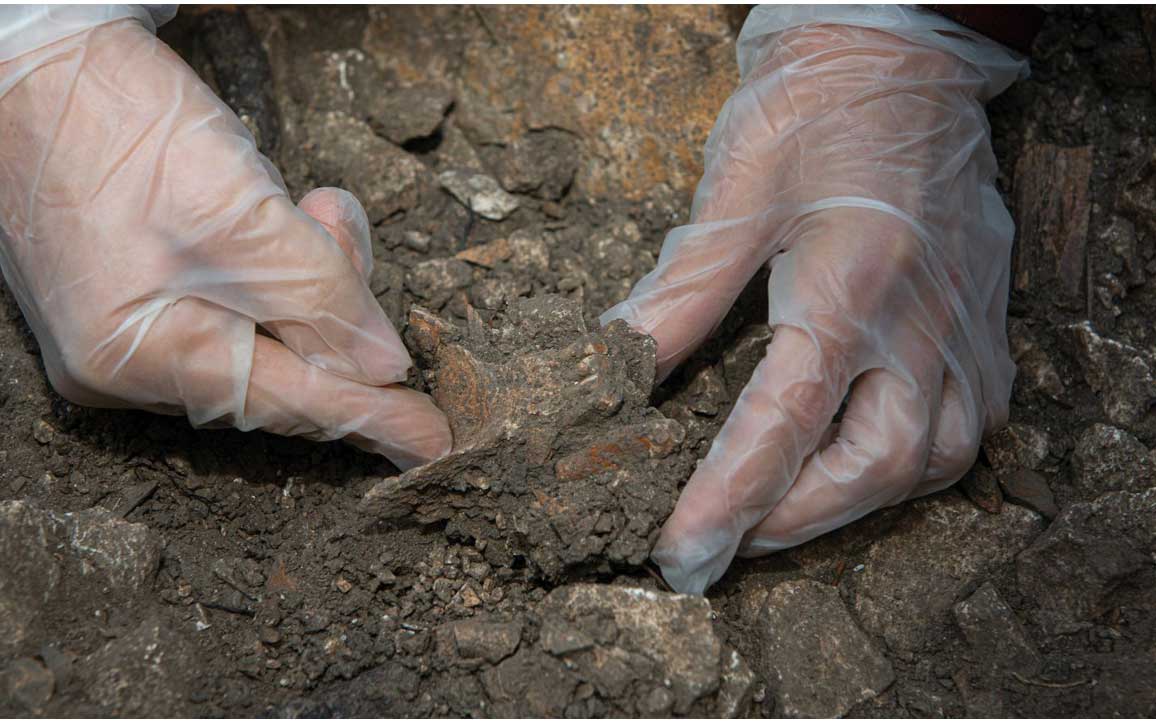
This Article From Issue
November-December 2024
Volume 112, Number 6
Page 332
In this roundup, associate editor Nicholas Gerbis summarizes notable recent developments in scientific research, selected from reports compiled in the free electronic newsletter Sigma Xi SmartBrief: www.smartbrief.com/sigmaxi/
Spider Uses Firefly Lures

Xinhua Fu, CC BY-SA
Experimental evidence shows a species of orb spider (Araneus ventricosus) can manipulate the light flashes of captured male fireflies (Abscondita terminalis) to appear female in origin, thereby attracting more males into its web. Non-webbed males attract female fireflies by emitting multipulse flashes from two abdominal light organs, but the webbed males studied set off single-pulse flashes using only one lantern—the pattern used by females. This luring behavior rarely occurred, however, when the spider was absent from its web. The authors believe the orb spiders control captured firefly signals through a prey-handling technique involving repeated wrap-bite attacks, although whether the bite alone is sufficient or if venom is also required remains unknown. Lead author Xinhua Fu from Huazhong Agricultural University in Wuhan, China, conceived the experiment when he noticed that certain orb spider webs rarely, if ever, contained female fireflies. The finding raises the question of whether other examples of predators manipulating prey through mimicry await discovery.
Fu, X., et al. 2024. Spiders manipulate and exploit bioluminescent signals of fireflies. Current Biology 34:R768–R769.
Recent Lunar Volcanism
Chang’e-5, China’s first sample-return mission, has provided evidence that the Moon was volcanically active within the past 120 million years. That’s far later than previous estimates of more than two billion years ago (and means the Moon was active for about 95 percent of its life) but fits some remote sensing estimates. Researchers at the Chinese Academy of Sciences in Beijing led the uranium-lead isotopic dating and analysis of glass beads sampled by Chang’e-5. Such beads form through melting due to either meteor impacts or volcanism, so researchers winnowed down their initial sample of 3,000 beads to three by examining physical and chemical characteristics that differentiate the two origins. These traits included proportions of sulfur isotopes as well as telltale ratios of magnesium oxide and calcium oxide to aluminum oxide. The authors say it is difficult to explain volcanism occurring long after the Moon’s interior cooled and its lithosphere thickened, but they suggest the sample’s high proportions of potassium, rare earth elements, thorium, and phosphorous could point to a source—perhaps a deep pocket in the Moon’s interior, where radiogenic heating caused the mantle to partially melt, produce magma, and erupt.
Wang, B., et al. 2024. Returned samples indicate volcanism on the Moon 120 million years ago. Science 385:1077–1080.
Robot-Driving Fungi

Robert Shepherd
A Cornell University–led team has harnessed fungi to control robots. The process draws on the light sensitivity of fungal cells and the bioelectric signals generated by the threadlike hyphae of king oyster mushrooms (Pleurotus eryngii), which were cultured on agar plates and grown onto a 3D-printed scaffold containing electrodes. Using a connected microcontroller unit and a signal processing model similar to the neural central pattern generators that let animals perform rhythmic tasks such as walking and breathing, the scientists created an interface that translated voltage spikes from hyphae into commands affecting the valves and motors of two chassis: a soft, walking, starfish-like robot and an untethered hard robot with four-wheel drive. Living tissues provide far more complex and dense arrays of sensors and actuators than roboticists can currently make, and biohybrids based on animals, bacteria, and plants are limited by their lifespans, environmental vulnerabilities, and culturing requirements. Fungi, though, are cheap and easy to grow, can last for months, and are remarkably hardy in extreme environments, including the Arctic and Antarctic, nuclear radiation sites, and highly acidic or saline conditions—features with a wide array of applications.
Mishra, A. K., J. Kim, H. Baghdadi, B. R. Johnson, K. T. Hodge, and R. F. Shepherd. 2024. Sensorimotor control of robots mediated by electrophysiological measurements of fungal mycelia. Science Robotics 9:eadk8019.
New Neanderthal Line

Ludovik Slimak
Scientists have concluded that two Neanderthal lineages coexisted in mutual isolation for tens of thousands of years until both groups became extinct. The findings are based on fossilized remains of a male—nicknamed “Thorin” after a J. R. R. Tolkien character—found in 2015 in a cave system in France’s Rhône Valley. The team, led by scientists at University of Copenhagen, traced Thorin’s genome to Neanderthals who lived more than 100,000 years ago. The authors report finding indications of inbreeding and a lack of genetic mixing between Thorin’s group and genetically younger Neanderthals who lived 10 days’ walk away—or with our Homo sapiens ancestors, who did interbreed with the younger lineage. These findings suggest that cultural factors such as isolationism, which can be evolutionarily detrimental, might have played a role in Neanderthal extinction. Generally, previous work has assumed a single Neanderthal lineage and has blamed its dying out on external factors, such as climate change.
Slimak, L., et al. 2024. Long genetic and social isolation in Neanderthals before their extinction. Cell Genomics 4:100593.

American Scientist Comments and Discussion
To discuss our articles or comment on them, please share them and tag American Scientist on social media platforms. Here are links to our profiles on Twitter, Facebook, and LinkedIn.
If we re-share your post, we will moderate comments/discussion following our comments policy.